Heavy weather sailing
By Paul TannerOn the beats I had the traveller about 1 foot from the end of the track and the main sheeted block to block. I concentrated on driving the boat through the waves and hiking out hard in the gusts. When the gusts were really strong I tended to point up higher and wait for it to pass, then bear way once the gust had gone and again concentrate on keeping the boat flat and driving through the waves. For tacking I first pulled the traveller in about another 3 to 6 inches and released the main about 6 " just to release some pressure on the leach. At the same time I was looking for a flatter sea section and driving the boat fast. I tacked as quickly as possible releasing a bit more main as I went about. Once through the wind and the main tacked I bore away and start sheeting in the main and let the traveller out. This whole process I guess takes less than 10 to 15 seconds. If the boat does stall then first I back the rudder. The boat will tack quicker going backwards. Once tacked and moving forward I again bear away and quickly release some more main just to get the boat moving. Releasing the main just allows the leach to twist more and drive the boat forward.
The worst thing that can happen is when the boat stalls and you don't back the rudders, once the boat is going backwards it will tack quickly but you must let the main out slightly just to get some power in the sail and get yourself moving again. At times the boat stalls and seems to sit in the same position even though you have the rudders hard over trying to get the boat to bear away. Itís like the boat is stuck. I do believe that releasing some main sheet stops this and allows the boat to drive forward. Once you have the boat moving then you can reset the traveller and sheet the main block to block. Having the mainsail flat is important to reduce power. So down haul on as tight as you can get it. The best way to adjust the downhaul is when you have the main in tight so the down haul line must be long enough so you can adjust it when you are sitting out. With the main block to block pull the downhaul in as tight as you can get it.
On the run it was a case of looking for gusts. As they approach and you feel the boat start to accelerate then I slowly bear away if the boat continues to accelerate I again try and bear away more. No sudden movements just feel the breeze coming and bear way to control the boat speed. Once the gust has past or you feel you can handle the strength of breeze then I harden up to improve the boat speed. Itís really zig-zagging looking at the breeze and where the waves are going. With the leg from 6 to 7 being a close reach on port tack I decided to gybe early. To gybe, I found it best to again look for the gusts and try and run dead down wind in a quieter section. I always force gybe the boat in these conditions. The main is a long way out and I try and grab the main sheet as close to the the tack as possible and pull the leach down hard as I force the main over. I feel this works because you have control of the main and the leach so that when you do gybe, you do not get this sudden gybe that will push you up into wind and may be into a nose dive. So with the gybe over early I sailed on to number 6. At 6 we had to harden up to into wind. So the traveller is still right out and I sheet in the main block to block. The leg from 6 to 7 was between a close reach and a fetch so very much over powered. So again concentrating on the gust and waves I tended to head up to de-power the rig and bear a way when I could. Sit right back and just drive the boat. Using the main again block to block and steering to de-power all the time. If I do become over powered and start flying a hull then I let some main out and bear way slight. Once back in control I get the main again block to block and drive the boat flat. Once past 7 it was a beat back through the start to number one. Traveller set in the best position that allowed me to have the main sail block to block. This for me was a bout 1 foot in. Again watch the gusts and make you decisions early on the strength of and direction of it. Bear away if you can and look for boat speed and drive through the waves. Because of the waves I was sat back further than normal just to stop the bows burying. Again I use my weight to keep the boat flat and move back and forward along the hull to keep the balance right.
In these conditions I tend to play the mainsheet on the beats. Some people use the traveller it what's works best for you. I tend to find once I have the traveller set and the main block to block that I use my weight my hiking out harder in the gusts and driving the boat either into wind to reduce speed / heel or bear away for speed.
You must concentrate all the time and look at the gusts and how the boat reacts. After a while it becomes automatic.


